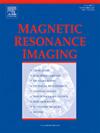Evaluating placental microstructure and microcirculation in predicting the progression of gestational hypertension to preeclampsia: a systematic comparison between virtual MR elastography, IVIM, ultrasound and lab indexes
IF 2
4区 医学
Q2 RADIOLOGY, NUCLEAR MEDICINE & MEDICAL IMAGING
引用次数: 0
Abstract
Objective
We aimed to utilize functional magnetic resonance imaging (fMRI), including placental virtual magnetic resonance elastography (vMRE), intravoxel incoherent motion (IVIM) parameters, MRI morphological parameters, ultrasound and laboratory indexes to predict the progression of GH to PE and differentiate patients with GH and controls.
Methods
Between January 2018 and March 2023, we retrospectively collected 382 pregnant women and ultimately included 68 subjects: 24 with PE, 14 with GH, and 30 healthy controls. The stiffness value (μdiff) from vMRE, true diffusion coefficient, pseudo-diffusion coefficient, perfusion fraction (f) from IVIM-based analysis, and apparent diffusion coefficient were calculated. MRI morphological parameters were evaluated using T2-weighted imaging. Doppler parameters of the umbilical artery (UA) and middle cerebral artery, cerebroplacental ratio (CPR), and laboratory tests were retrospectively collected. ANOVA analysis compared parameters across three groups. Predictive performance was evaluated using receiver operating characteristic curve analysis and area under the curve (AUC).
Results
Doppler parameters (pulsatility index, resistance index, peak systolic velocity/end-diastolic velocity in UA, and CPR) and fMRI parameters (μdiff and f) effectively predicted PE in patients with GH. The fMRI combined model exhibited superior predictive efficacy compared to the Doppler model (AUC, 0.845 vs. 0.792). Their combined model further improved predictive efficacy (AUC, 0.920). The prothrombin time level, μdiff and f could identify patients with GH and controls, with no substantial differences in all Doppler parameters.
Conclusions
vMRE and IVIM parameters might be superior to ultrasound and laboratory indexs in predicting the progression of GH to PE and differentiating patients with GH and controls.
评估胎盘微观结构和微循环在预测妊娠高血压向子痫前期进展中的作用:虚拟磁共振弹性成像、IVIM、超声和实验室指标的系统比较
目的:利用功能磁共振成像(fMRI),包括胎盘虚拟磁共振弹性成像(vMRE)、体素内非相干运动(IVIM)参数、MRI形态学参数、超声和实验室指标来预测GH向PE的进展,并区分GH患者和对照组。方法:2018年1月至2023年3月,我们回顾性收集了382名孕妇,最终包括68名受试者:24名PE患者,14名GH患者和30名健康对照。计算vMRE计算的刚度值μdiff、基于ivim分析的真扩散系数、伪扩散系数、灌注分数f和表观扩散系数。采用t2加权成像评估MRI形态学参数。回顾性收集患儿脐动脉(UA)、大脑中动脉多普勒参数、脑胎盘比(CPR)及实验室检查结果。方差分析比较了三组的参数。采用受试者工作特征曲线分析和曲线下面积(AUC)评价预测效果。结果:多普勒参数(脉搏指数、阻力指数、UA和CPR的峰值收缩期速度/舒张末期速度)和功能磁共振参数(μdiff和f)能有效预测GH患者的PE。与多普勒模型相比,fMRI联合模型具有更好的预测效果(AUC, 0.845比0.792)。联合模型进一步提高了预测效果(AUC, 0.920)。凝血酶原时间水平、μdiff和f均能识别GH患者和对照组,各多普勒参数无明显差异。结论:vMRE和IVIM参数在预测GH向PE的进展和区分GH与对照组患者方面可能优于超声和实验室指标。
本文章由计算机程序翻译,如有差异,请以英文原文为准。
求助全文
约1分钟内获得全文
求助全文
来源期刊

Magnetic resonance imaging
医学-核医学
CiteScore
4.70
自引率
4.00%
发文量
194
审稿时长
83 days
期刊介绍:
Magnetic Resonance Imaging (MRI) is the first international multidisciplinary journal encompassing physical, life, and clinical science investigations as they relate to the development and use of magnetic resonance imaging. MRI is dedicated to both basic research, technological innovation and applications, providing a single forum for communication among radiologists, physicists, chemists, biochemists, biologists, engineers, internists, pathologists, physiologists, computer scientists, and mathematicians.
 求助内容:
求助内容: 应助结果提醒方式:
应助结果提醒方式:


